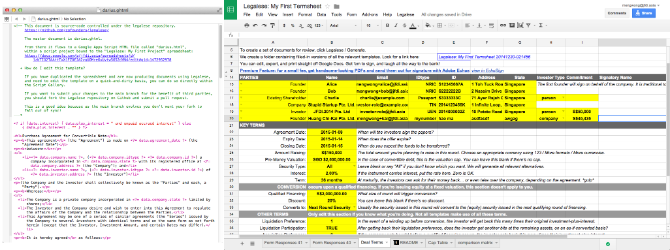1.
Introduction: Applying Four Computational Themes ^
Computational ideas are now sweeping through the legal industry. In the words of Marc Andreessen, a computer scientist and technology investor, «software is eating the world». [Andreessen 2011] The legal industry is no exception. This paper chooses the field of startup investing as a fertile ground to investigate the applications of four major computational themes – automation, visualisation, collaboration, and formalisation – to the legal field.
1.1.
Context: Early-Stage Fundraising ^
2.1.
Document Assembly: Automation for Lawyers ^
2.2.
Contract Visualisation: Term Inputs and Financial Outcomes ^
Capitalization tables (or cap tables) are widely used by entrepreneurs and investors to analyze founders' and investors' percentage of ownership and other important information which can become quite complex due to different stock classes, convertible notes, stock options, and so on. When cap tables are visualised, it becomes easier to keep track of such information and subsequent issuance of stock, options, and financing events.3 Early stage investments hold the promise of outsize capital gains. Agreements are scrutinised by both founders and funders to understand profit potential under different scenarios. These, too, can be visualised for ease of understanding.4
2.3.
Contract Collaboration: Editing and Negotiation ^
2.4.
Template Collaboration: Online Document and Clause Repositories ^
2.5.
Publicly Available Term Sheets and Investment Agreements ^
In recent years, technology investors and their Associations have published templates for investment agreements. In 2006, the U.S. National Venture Capital Association kicked off this movement with its model venture capital financing documents8, followed by Y Combinator with its Series AA documents (prepared with WSGR).9 In 2009, TechStars open sourced their model documents (prepared with Cooley).10 In 2010, SeriesSeed.com appeared (by Fenwick & West.).11 Soon, the field was so crowded that commentators started publishing comparative analyses of the documents. As the saying goes: «A man with a watch knows what time it is. A man with two watches is never sure».
2.6.
The Promise of Formalisation ^
2.7.
Combinations of Themes in Recent Commercial Initiatives ^
3.
Our Prototype of an Automated Contract Generation Toolkit: Legalese.io ^
Figure 3: Screenshots of the Web Interface and the source XML of the Automated Contract Generation Toolkit
4.
Conclusion ^
5.
References ^
Andreessen, Mark, Why Software Is Eating The World. The Wall Street Journal, August 20, 2011, http://www.wsj.com/articles/SB10001424053111903480904576512250915629460 [Accessed January 5, 2015] (2011).
Curtotti, Michael, Computational Tools for Reading and Writing Law http://cs.anu.edu.au/people/Michael.Curtotti/ and Contract Tools at http://buttle.anu.edu.au/contracts/ [Accessed January 5, 2015] (n.d.).
Feld, Brad & Mendelson, Jason, Venture Deals. Be Smarter than Your Lawyer and Venture Capitalist. Wiley (2013).
Flood, Mark D. & Goodenough, Oliver R., Contract as Automaton: The Computational Representation of Financial Agreements, http://papers.ssrn.com/sol3/papers.cfm?abstract_id=2538224 [Accessed January 5, 2015] (2014).
Haapio, Helena, Making Contracts Work for Clients: towards Greater Clarity and Usability. In E. Schweighofer et al. (eds): Transformation of Legal Languages. Proceedings of the 15th International Legal Informatics Symposium IRIS 2012. Band 288. Österreichische Computer Gesellschaft, Wien, pp. 389–396 (2012).
Haapio, Helena, Next Generation Contracts. A Paradigm Shift. Doctoral dissertation. Lexpert Ltd, Helsinki (2013).
Passera, Stefania, Haapio, Helena & Barton, Thomas, Innovating Contract Practices: Merging Contract Design with Information Design. Proceedings of the IACCM Academic Forum on Contract and Commercial Management 2013, Phoenix, pp. 29–51 (2013).
Passera, Stefania, Haapio, Helena & Curtotti, Michael, Making the Meaning of Contracts Visible – Automating Contract Visualization. In E. Schweighofer et al. (eds): Transparency. Proceedings of the 17th International Legal Informatics Symposium IRIS 2014. Band 302. Österreichische Computer Gesellschaft OCG, Wien, pp. 443–450 (2014).
Surden, Harry, Computable contracts. UC Davis Law Review, Vol. 46, pp. 629–700. http://lawreview.law.ucdavis.edu/issues/46/2/Articles/46-2_Surden.pdf [Accessed January 5, 2015] (2012).
Szabo, Nick, Smart Contracts, http://szabo.best.vwh.net/smart.contracts.html [Accessed January 5, 2015] (1994).
Tan, Gillian, Spreadsheet Mistake Costs Tibco Shareholders $100 Million. The Wall Street Journal, October 16, 2014, http://blogs.wsj.com/moneybeat/2014/10/16/spreadsheet-mistake-costs-tibco-shareholders-100-million/ [Accessed January 5, 2015] (2014).
Ward, Henry, Broken cap tables, January 2, 2015 https://medium.com/@henrysward/broken-cap-tables-bbf84574a76a [Accessed January 5, 2015] (2015).
Wilmerding, Alex, Term Sheets & Valuations – A Line by Line Look at the Intricacies of Term Sheets & Valuations. Aspatore Books (2006).
Meng Weng Wong, Social Engineer, JFDI.Asia, 71 Ayer Rajah Crescent #05-16, 139951 Singapore, SG, mengwong@pobox.com; http://www.mengwong.com/
Helena Haapio, Business Law Teacher & Postdoctoral Researcher, University of Vaasa / International Contract Counsel, Lexpert Ltd, Pohjoisranta 20, 00170 Helsinki, FI, Helena.Haapio@lexpert.com; http://www.lexpert.com
Sebastian Deckers, Frontend Cofounder, Cofounders Pte Ltd, Singapore, SG, sebastiaan@cofounders.sg; http://www.cofounders.sg
Sidhi Dhir, Executive Director, The Indus Entrepreneurs, 71 Ayer Rajah Crescent #05-16, 139951 Singapore, SG, sidhidhir@gmail.com; https://singapore.tie.org
- 1 https://www.wsgr.com/WSGR/Display.aspx?SectionName=practice/termsheet.htm.
- 2 http://www.cooleygo.com/documents/y-combinator-safe-financing-document-generator.
- 3 For an illustration, see «Captables made easy as pie» at https://captable.io/home.html. Captable.io offers a platform which can be used to create graphical representations of cap tables. A demonstration is available at https://captable.io/demo. According to the web page, «Captable.io keeps everyone on the same page, provides transparency and helps avoid costly mistakes».
- 4 An illustration of how exit scenarios can be modeled and visualized is provided by Captable.io at https://www.captable.io where one of the images («Understand outcomes») shows possible shareholder returns based on various exit valuations.
- 5 http://www.contractstandards.com/.
- 6 http://www.lawdepot.com/; https://lawcanvas.com/; http://www.docracy.com/; http://www.peppercorn.it/en.
- 7 http://legal.cf.sg/; https://github.com/cofounders/legal.
- 8 http://www.nvca.org/index.php?option=com_content&view=article&id=108&Itemid=136.
- 9 https://www.ycombinator.com/documents/.
- 10 http://www.techstars.com/docs/.
- 11 http://www.seriesseed.com/.
- 12 Legal XML is a markup for natural language, but is not in itself a formal, Turing-complete language.
- 13 http://www.shakelaw.com/.
- 14 https://www.esharesinc.com/.
- 15 http://www.seal-software.com.
- 16 http://ebrevia.com/.
- 17 https://lexmachina.com/.
- 18 https://www.echosign.adobe.com/en/integrations/echosign-salesforce.html.
- 19 Both software and templates are available on GitHub at https://github.com/cofounders/legal/.
- 20 These images, and the resulting signature-ready PDF, are available at http://legalese.io/demo/.








